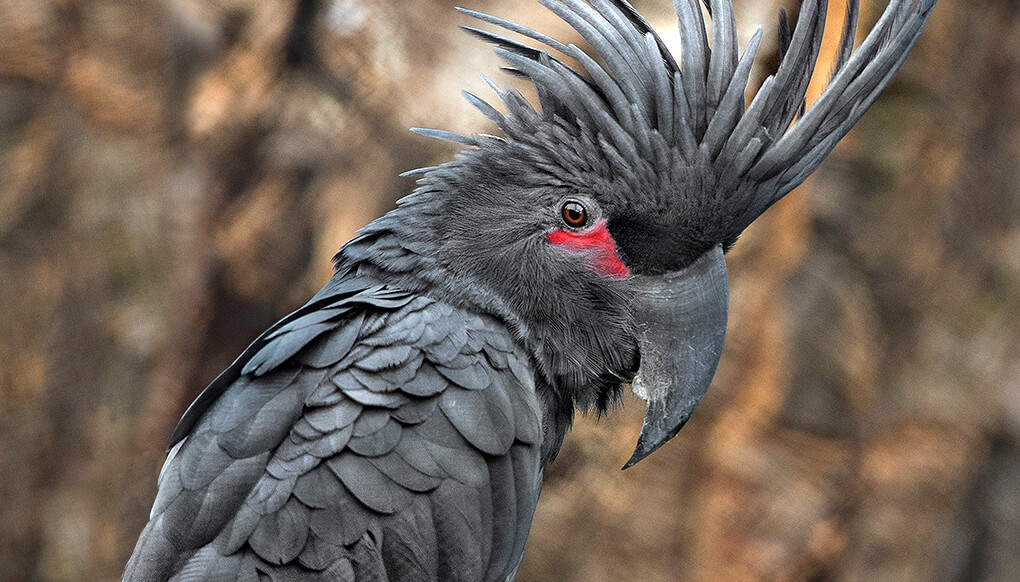
"Some males were consistently fast, some were slow, while others loved a little flourish at the beginning. "Each of 18 male palm cockatoos, known for their shyness and elusiveness, was shown to have its own style or drumming signature," said Professor Heinsohn. This was slowly acquired over the seven year study by patiently stalking the birds through the rainforest with a video camera. However, most species are relatively large birds. There are 21 different species of, ranging from the tiny Cockatiel to the massive Palm Cockatoo.

Professor Heinsohn said the palm cockatoo's ability to drum has been known for a long time but this is the first research to secure the footage to analyse it. Aves Psittaciformes Cacatuidae Cockatoo By Animals Network Team The Cockatoo is actually a group of parrots in the Cacatuidae family. During the day they roost near food or water sources and at night roost in or near a nest tree. They choose large trees for nesting and roosting. "The icing on the cake is that the taps are almost perfectly spaced over very long sequences, just like a human drummer would do when holding a regular beat." Palm cockatoos are found in rainforests, including gallery forests, forest edges, monsoon woodlands, eucalypt and paperbark woodlands, partly cleared areas, and dense savannas. "The large smoky-grey parrots fashion thick sticks from branches, grip them with their feet and bang them on trunks and tree hollows, all the while displaying to females," said Professor Heinsohn, from the ANU Fenner School of Environment and Society. Initial results confirm that the behavior is remarkably analogous to musical instrument use in humans, to the extent that it is likely to constitute the only animal parallel for this complex human behaviour.But the shy and elusive palm cockatoo, iconic to Cape York Peninsula in far North Queensland, plays the drums and crafts the sticks. We have succeeded in videoing this incredible behaviour on over 60 occasions and have analysed the patterns and context of the performance of males. Our work includes comparison of calls between the populations (eg west coast versus east coast) and population genetics to determine the connectedness of the populations, and will lead to a population viability analysis to determine the conservation status of this species in Australia. We have extended this research to include the other populations on Cape York Peninsula to see whether they are connected enough to buffer the east coast population from decline. On this basis palm cockatoos were declared Vulnerable by the Australia Government which led to greater legal protection. Females were shown to lay only one egg every two years on average, and that one egg only had a 20% chance of leading to a fledgling. This population was shown to be in steep decline due to very low rates of reproduction. The initial emphasis was on breeding biology and ecology of palm cockatoos in the rainforests of the north east coast. Members of our team have been researching this species since 1999. to slow breeding rates and habitat loss Listen Palm cockatoo numbers predicted to halve in 50. We climb the trees when safe but use cameras mounted on tall poles to see inside the nests when the wood is too old or rotten to support our weight. Habitat/range: Probosciger aterrimus is found only on the Cape York Peninsula of northern Australia, the Aru Islands, Papua New Guinea and other surrounding. Pronunciation of Palm Cockatoo with 1 audio pronunciation.

They are shy and elusive and all but impossible to catch, necessitating alternative methods for studying them, and lots of patience! Only by understanding their movements and behaviour intimately have we been able to approach, observe and gain precious DNA samples for population genetic analysis. They only occur in the small bands of woodland adjacent to rainforest. Palm cockatoos are found in remote parts of Cape York Peninsula 10-20 hours drive north of Cairns. The palm cockatoo is found in rainforests and woodlands of New Guinea and Cape York Peninsula, Queensland, Australia. Our project explores this remarkable behaviour and the aspects of intelligence required to make and use tools in such a human-like fashion. They then grasp the drumsticks in one foot and beat them against a hollow trunk as part of their display to females. The males make drumsticks by breaking off a branch, stripping the foliage and trimming to appropriate length. Palm cockatoos are the only non-human species that manufactures and uses a sound tool. We study the demography and dynamics of the entire population on Cape York Peninsula and the causes of their decline including large scale habitat loss from mining, changed fire regimes and low reproductive success. They are incapable of excavating on their own and have to depend on the hollows that form as a result of branches falling off the tree or caused by termites and fungi or courtesy of the woodpeckers inhabiting the same range. Palm cockatoos are large, charismatic and emblematic birds of northern Australia and New Guinea yet our research suggests they are in steep decline. They live in ready-made tree hollows, and are called cavity nesters.

Conservation and tool use in palm cockatoos


 0 kommentar(er)
0 kommentar(er)
